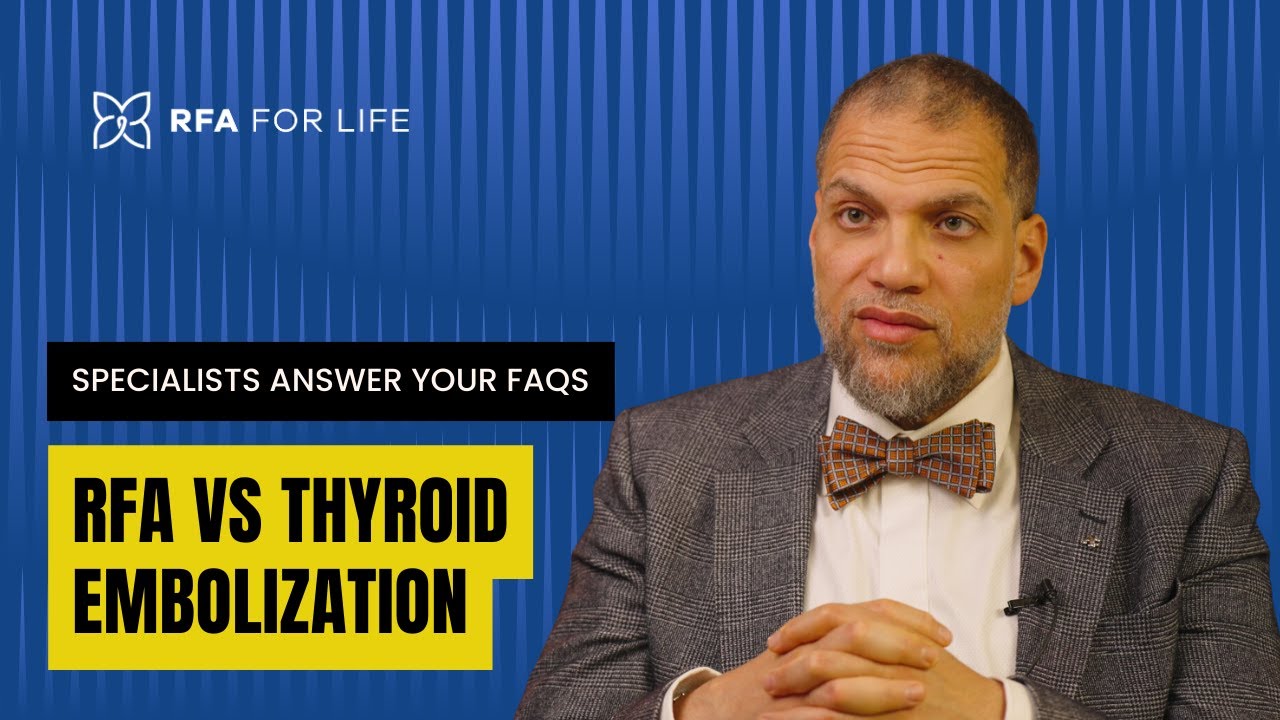SUMMARY: Learn the key differences between thyroid embolization and radiofrequency ablation (RFA) for treating thyroid nodules. RFA is minimally invasive, safer, and more effective for preserving thyroid function, while embolization is more invasive with higher risks. Consider consulting with an RFA specialist for optimal treatment options.
- Thyroid RFA: Destroys only unhealthy thyroid tissue, preserving function and reducing complications.
- Thyroid Embolization: Blocks blood flow, affecting both unhealthy and healthy tissue, with higher risks.
- RFA Benefits: Minimally invasive, effective, and low risk with minimal downtime.
- Embolization Risks: Less researched, and potentially riskier than RFA.
- Consultation: Seek an RFA doctor for tailored advice and less invasive treatment.
Today, there are more options than ever for the treatment of thyroid nodules. In the past, patients were limited to surgical interventions, requiring recovery and lifetime medications. Now, advances in technology mean there are far fewer invasive treatment options available. For example, your doctor may have discussed thyroid embolization or thyroid radiofrequency ablation (RFA).
When comparing embolization vs. ablation, it’s crucial to have all the facts. In this guide, we’ll explain the basics of both procedures so you can make an informed decision. Consider reading to learn whether thyroid embolization or RFA is right for you.
What Is the Difference Between Ablation and Embolization?
The easiest way to understand each treatment is to understand what happens to your thyroid tissue during each procedure. We’ll define key medical terms below to make both treatments easier to understand.
Ablation vs. Embolization: Definitions
Ablation
In medical terms, ablation means to remove or destroy unwanted tissue. In the case of thyroid ablation, unhealthy thyroid tissue is destroyed using heat. During thyroid RFA, the heat is localized around the tip of a special needle called an electrode. It is carefully controlled to target and destroy only the unhealthy tissue.
Embolization
In contrast, embolization means to block blood flow to a specific part of the body. You may have heard this term used in a different context. For example, an embolism is a blockage in a blood vessel. The difference is that embolization is deliberate and controlled to starve the thyroid of blood.
As a result, the nodule will stop growing. However, healthy tissue may be damaged in the process.

Envisioning RFA for Thyroid vs Embolization for Thyroid
Dr. Emal Kandil, Chief of General, Endocrine and Oncological Surgery Division and a Professor of Surgery at Tulane’s School of Medicine, has a helpful way of envisioning both procedures. “Think of the thyroid as an avocado,” he recommends.
In Dr. Kandil’s example, the pit of the avocado represents your nodule. The green flesh is your healthy thyroid tissue.
In Thyroid RFA, the electrode is introduced directly to the pit of the avocado. As a result, the pit will be destroyed, but the healthy, green flesh will be left behind. Thus, the thyroid can continue to function normally. There is a lower chance of recurrence and no need for lifetime medications.
In Thyroid Embolization, the procedure cuts off blood flow to the entire thyroid (or “avocado”). Both the pit and the healthy green tissue will be damaged during this process. Dr. Kandil tells us it is more invasive, with a higher risk of complications compared to RFA.
Hear more about embolization vs. ablation from Dr. Kandil in the video below:

Benefits and Disadvantages of Embolization vs. Ablation for the Thyroid
There are currently hundreds of published clinical studies on the use of thyroid ablation. The overwhelming consensus is that it’s minimally invasive, effective, safe, and low-risk, with little downtime.
Research has found that the majority of patients saw a long-term reduction in nodule volume after treatment. They also experienced higher satisfaction and fewer complications, such as voice changes, after the procedure.
In contrast, there is less evidence to support thyroid embolization. Dr. Kandil suggests it may be beneficial in conjunction with RFA or for a select group of patients. Overall, thyroid embolization is riskier and more invasive. It is likely not the ideal first-line treatment for most nodules.
Currently, there is not enough research to understand who the best candidates for thyroid embolization might be. If your doctor recommends embolization, consider getting a second opinion to learn about less invasive options, such as RFA.
Connect with a Thyroid RFA Doctor
Interested in learning more about minimally invasive treatment options for thyroid nodules? We can help connect you with a qualified doctor in your area. Access our physician finder to find a provider in your region or learn more about RFA.




